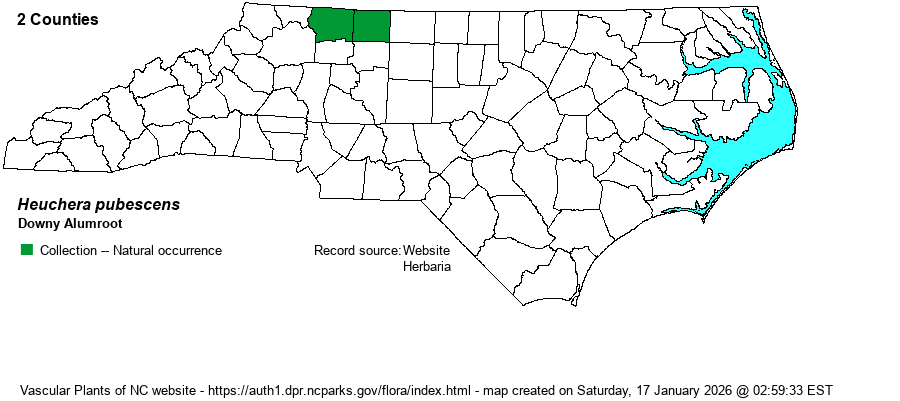| Author | Pursh | |
| Distribution | Apparently restricted just to the far northwestern Piedmont in the state, apparently just in the Sauratown Mountains. Specimens at NCU (the only herbarium that the website editors feel that the specimens have been recently vetted) only from Surry and Stokes counties. NCNHP lists a record from neighboring Yadkin County, but this likely relates to a mapping error. There are many specimens in other herbaria for several Mountain counties, mainly Madison and Haywood, but it is believed they refer to other species -- H. americana or H. aceroides. Note that the range and habitat of the species listed in RAB (1968) -- "Rich calcareous woods, very rare; Madison Co., N.C." is now known to be incorrect.
Weakley (2018) gives the range as "Primarily a species of the Ridge and Valley Province of PA, MD, WV, and VA", but that it ranges south "only to a few locations in the upper Piedmont of NC". | |
| Abundance | Very poorly known, but probably rare; essentially known from Hanging Rock and Pilot Mountain state parks, with a handful of records. As with H. hispida, the NCNHP also gives this species a State Rank of S1 and a Significantly Rare status. Each could perhaps be ranked as S1?, though it is appropriate for both to be tracked as rare species. | |
| Habitat | This is a species of rocky forests, including rock outcrops. The Digital Atlas of Virginia Flora website states that it is "tolerant of a range of soil and rock chemistries". This appears to be the case in NC, as these two state parks tend to have rocks that are not mainly of mafic or calcareous material, but are rather felsic (acidic). Needless to say, more detailed information about the microhabitats in the state is needed. The NCNHP rare plant list simply says "rock outcrops". | |
| Phenology | Blooms from May to July, and fruits shortly after flowering. | |
| Identification | This is another typical and confusing alumroot. Like others, it has several large basal leaves on long petioles, with large rounded blades with cordate bases, strongly serrated margins, and some hint of lobing. In this species the upper leaf surface is rather pubescent, not strongly hispid as in H. hispida, nor quite as glabrous as in H. americana. It has flowers with a strongly angled or urn-shaped calyx, and the flowers show only a slight extension of the stigmas and styles beyond the petals. H. caroliniana grows in the same area and places, but it has a rounded (hemi-spherical) calyx, as opposed to a more angular calyx in H. pubescens. H. pubescens has the calyx lobes noticeably longer than on H. caroliniana -- about 9-10 mm (2/5-inch) compared with only 3.5 mm (1/8-inch) in H. caroliniana. Thus, when viewing the two flowers from the side, H. pubescens will look mostly green owing to the longer calyx lobes; the whole flower tends to looks "blocky" or rectangular as compared with a narrower flower of the others. Needless to say, you must be careful and cautious when identifying this scarce species in NC, and you may need to collect a flower or leaf, if legal to do so. | |
| Taxonomic Comments | None
| |
| Other Common Name(s) | Marbled Alumroot | |
| State Rank | S1 | |
| Global Rank | G4 | |
| State Status | SR-P | |
| US Status | | |
| USACE-agcp | | |
| USACE-emp | | |

